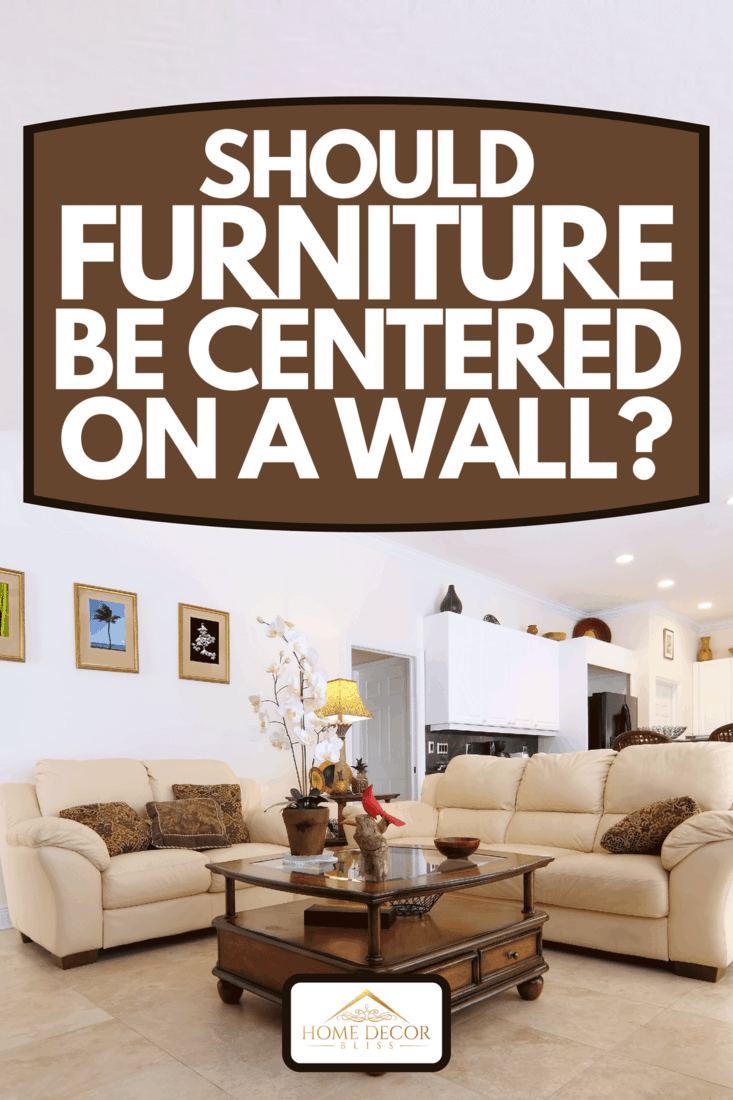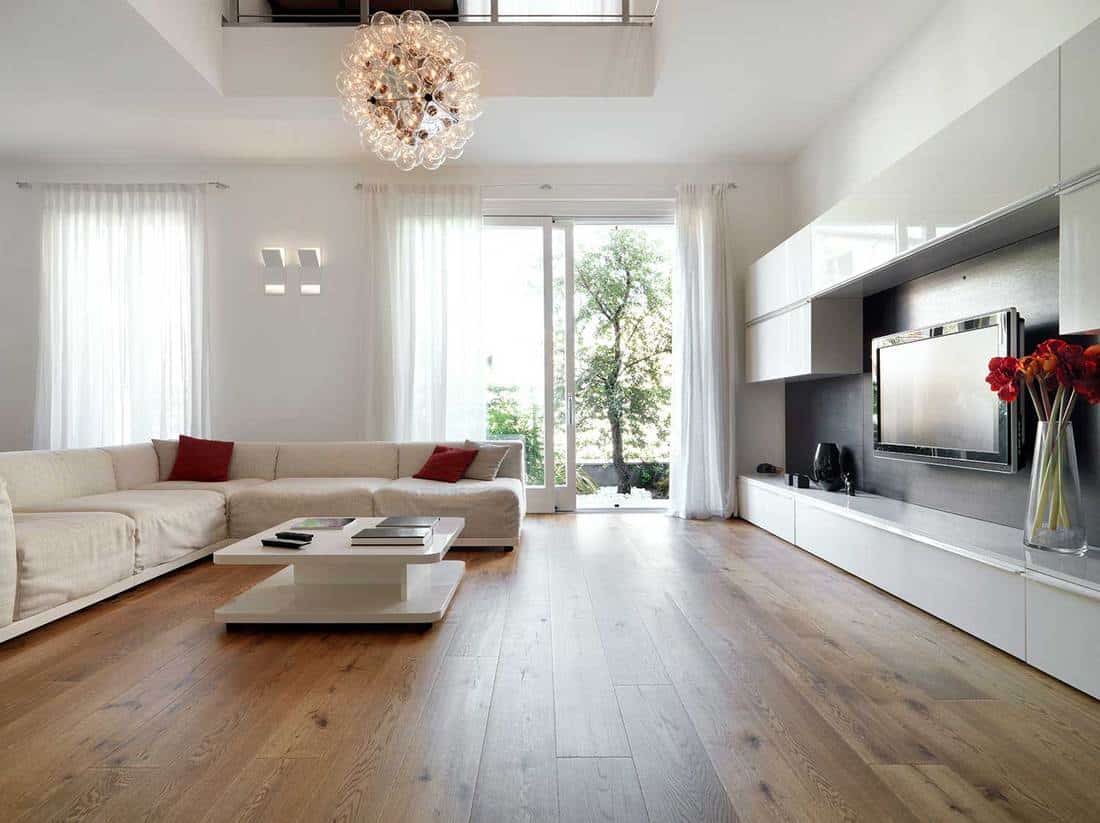With furniture, figuring out how to position it makes a world of difference in how your room looks and feels. You need to have the right position for your furniture to make your room feel coordinated, open, and airy. That's why knowing whether or not your furniture needs to be centered on the wall matters. To find out the truth behind this debate, we researched what top experts suggest.
Centering your furniture can be a good choice for a focal point in your room, but pressing all your furniture up against a wall is actually a bad idea. Putting too much of your furniture flush against the wall can make your room disproportionate or even give the look of a designer that "tried too hard."
Coming up with that perfect balance or positioning scheme can be difficult, especially if this is your first time decorating a home. To find out how you can work with your furniture layout, keep reading. We've got tons of research.

Why Shouldn't You Center Furniture Against The Wall?

We may include affiliate links and curated AI content to highlight top design styles.
There isn't just one reason you should avoid doing this when you have a home you need to decorate. There are a bunch of reasons why doing this isn't a good idea. They are as follows:
- The most commonly cited reason is that it can make your room look smaller than it is. (We'll get into that later.)
- If you do this with all your furniture, you will end up with a room that looks very boring and overly-stylized.
- Too much symmetry can make a home look a little eerie, almost like a real-life dollhouse.
Does Placing Furniture On The Wall Make A Room Look Bigger?
To understand this concept, it's important to remember that there is a little bit of nuance to the full answer. Larger pieces of furniture tend to work better when pressed up against a wall because it helps max out floor space. If you use a wall to prop up smaller furniture pieces, it actually backfires and makes the room look cramped.
Knowing this small piece of information can significantly impact how your home's layout will look and helps debunk the whole "everything centered against the wall" look.
What Pieces Of Furniture Work Best Against A Wall?
While there is always going to be a need to keep some of your furniture off the walls, certain pieces tend to work better adjacent to a wall. The most common pieces of furniture that you might want to keep flush against a wall include:
- TV and entertainment consoles
- Cabinets
- Dressers
- Floor lamps
- Beds
- Nightstands
Do Corner Sofas Have To Go In A Corner?
Nope! While corner sofas always look cozy in a corner, they can also be in the middle of a living room and still look stylish. Corner sofas are about breaking up the continuity and symmetry in a room while giving people a place to chill out. When adding a corner sofa, it's best to think of the sofa as a layout perk rather than something that needs to be stuck in a corner no matter what.
Why Does Too Much Centering Look Strange?
Simply put, we all tend to subconsciously associate excessive symmetry and centering with something that doesn't look right. In nature, seeing perfectly symmetric surroundings just doesn't happen. As a result, we tend to view overly symmetric rooms as unnatural, making people feel a little nervous. One could even say it's the "Uncanny Valley" of interior design.
To combat this, add decorations and furniture pieces that help break up the monotony of heavy-handed symmetry. Even a smartly-placed lamp or a lovely vase can help break up the monotony and give you a more balanced, human ambiance to your room.
How Much Space Should Be Between Furniture And Wall?

This isn't something that can be answered with a single rule of thumb. However, we can offer a little insight when judging a reasonable distance between furniture and the wall. If you have a large furniture piece that acts as a focal point, like a bed, you can place it flush against the wall as long as there is some space between other pieces of furniture and the wall. The same can be said with TV consoles, cabinets, and dressers.
However, if it's something along the lines of a small sofa, a chair, or a table, at least a foot of space is usually ideal. Having some space for walking is a must, but it goes deeper than that. Researching how much space per person or how much space you need between different items can help you find the best proportions.
Do You Center A Picture On The Wall Or Over Furniture?
The best way to center a picture depends on what is underneath it. The tips below will help you keep your artwork perfectly positioned:
- You should position pictures that aren't above furniture fixtures at 60 inches off the ground. This puts them at eye level.
- Motivational posters or other artwork placed above sofas and couches should be placed 2/3 the piece's width above the sofa.
- If you just placed a picture above other parts of your furniture, giving it at least four to six inches of space is advisable.
- If you have a cluster of photographs that you're using as a collage, avoid making your collage perfectly symmetrical. Follow spacing suggestions for typical posters.
How Do You Choose A Focal Point For Your Furniture?
Your focal point is usually the item that stands out for one reason or another. An excellent way to choose the focal point is to use your bed (if it's a bedroom) or get a single signature item with a unique curve or an extra-large size compared to most other furniture. The more it stands out, the more likely it is that it's a good focal point.
Important Tips To Arrange Your Furniture By
Furniture arrangements are never easy to plan out, even if you've browsed a bunch of online forums on the topic. These tips will help make sure that you get the most out of your furniture arrangements:
- Whenever possible, leave at least three inches of space between furniture and the walls.
- If you're outfitting your living room, tilt chairs towards each other at an angle.
- Always try to balance the sizes of the furniture that you want to add to a room. Balance is good; extreme symmetry is not.
- When you're arranging your furniture, keep in mind the traffic and path people will take in a room.
- Don't be afraid to take inspiration from cool shots of well-coordinated rooms from home design blogs or upscale magazines.
Conclusion
Getting your furniture arranged well isn't easy, especially when you find out that the old trick of pushing stuff against a wall doesn't work. After all, it's disheartening to find out that the reliable method doesn't work. However, some easy ways to make things work, like adding space for smaller furniture pieces and putting larger ones closer to the wall. With a little work, you'll be able to plan things out smoothly.



